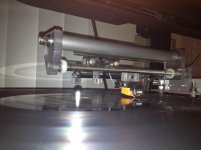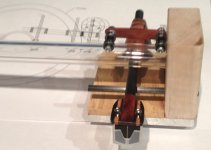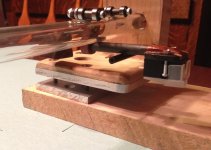Amen to that Bill, long live them !
And with that lets get on to more practical matters. Colin, how do you set the tracking force? This is the one difficulty I see with these steel on glass designs. There is enough drag from static friction (sticktion) that scales of any sort don't give you the actual tracking force. The technique I've come up with is to set the counterweight so that the stylus is just grazing the record. Multiple jiggles and bumps will eventually hit that point. Then place a weight (small lump of clay) which has been accurately weighed and adjusted for the desired tracking force on the headshell over the stylus. For me that works but it doesn't look nice. Could build a nice looking platform and have proper weights rather than lumps of clay. What's your take on this? Also what tracking forces are you able to run?
BillG
Last edited:
Or, take the opposite approach
What if you calculated the value of a weight equivalent to 1gm at the headshell and placed it on the counterweight, then performed your "just touching" exercise. After that, take the weight off the counterweight and, if your math is right, you have a gram weight at the headshell.
What if you calculated the value of a weight equivalent to 1gm at the headshell and placed it on the counterweight, then performed your "just touching" exercise. After that, take the weight off the counterweight and, if your math is right, you have a gram weight at the headshell.
Has anyone determined whether or not an acrylic tube would be an acceptable alternative to glass? It would certainly be easier to cut.
You can make an arm work with a plastic tube but it is only really suitable for proof of concept and even then I would not recommend it. I think Doug built one with a PVC rube. The problem is way too much friction the plastic is way too soft. You need the tube to be hard as possible harder than your bearing material so the bearing wears and not the tube. Best regards Moray James.
You can make an arm work with a plastic tube but it is only really suitable for proof of concept and even then I would not recommend it. I think Doug built one with a PVC rube. The problem is way too much friction the plastic is way too soft. You need the tube to be hard as possible harder than your bearing material so the bearing wears and not the tube. Best regards Moray James.
As hard as possible -
so if we look at hardness
sapphire glass is Mohs 9, whereas quartz glass is only Mohs 5,5 – 6,5, not to speak of borosilicate, which is even softer.
Hi Bill,
I set the latest arm up with a tracking force gauge then dial in by sight. With enough practice you can see where the cantilever should be displaced to, being a short arm it is hard to fully set by a gauge. Your ears will tell you when tracking is just right.
As far as glass, as long as its harder than the bearing material it's good enough, as long as its smooth you will only just be spending more money with exotic quartz and sapphire.
Colin
I set the latest arm up with a tracking force gauge then dial in by sight. With enough practice you can see where the cantilever should be displaced to, being a short arm it is hard to fully set by a gauge. Your ears will tell you when tracking is just right.
As far as glass, as long as its harder than the bearing material it's good enough, as long as its smooth you will only just be spending more money with exotic quartz and sapphire.
Colin
The Build Continues
Progress is being made slowly. Had a few design details to complete such as how to keep it simple but yet allow alignment and height adjustment. This is just pieced together for the moment. That will become more obvious at the end of the build. A version of what has already been done. Need to finish a few parts and drill/tap a few holes before final assembly. Hope it works!
Progress is being made slowly. Had a few design details to complete such as how to keep it simple but yet allow alignment and height adjustment. This is just pieced together for the moment. That will become more obvious at the end of the build. A version of what has already been done. Need to finish a few parts and drill/tap a few holes before final assembly. Hope it works!
Attachments
I am no engineer so do not know about the finer points of arm design but I do wonder about the leverage between where the arm tube is mounted in the carriage and the mounting points of the bearings. this, I imagine would cause a small rocking movement with any vertical movement of the cartridge therefore moving the cartridge back and forth very slightly. If the arm, counterweight assembly was pivoted on ball pen tips or a knife edge on brackets suspended from the bearing shafts ( similar to the terminator), would this be a better arrangement or would there not really be any difference?
jamikl
jamikl
if you want to be able to play severe warps that is the way to go. The focus with the Cantus is to make the arm/carriage assembly as rigid as possible and to eliminate as much motion as possible. The less back and forth motion (tip scribing an arc) the better. You want the arm to have free motion in the horizontal plane and that's it. Best regards Moray James.
So is anybody listening to their builds yet?, since the addition of the 3/4" Alu support bar this has made another leap up in sound quality in the bass, better solidity reaching deep Down with the addition of lowering the tubes resonant Q. This is similar to what clearaudio does with the simplicity of a single larger tube which is internally damped with foam sheet for potential ringing.
Colin
Colin
Listening??? You Bet! But last night before the listen I switched from the old Empire 2000E to the Ortofon OM 40 with the OM 10 stylus. That was a major step upwards. Smooth, refined, plenty of impact. Percussion really stands out. Listened to some serious pipe organ stuff. Mostly Bach. The degree of presence was astounding but the best was that with all those pipes speaking at the same time and at fairly high volume, they were not smeared at all. The contrapuntal lines were cleanly delineated and the big diapasons were so solid. Gave my old isobarik clones a real workout. Was great with the headphones too. One other modification had also been done. The arm lift is a long piece of quarter inch aluminum tube from the hobby shop. Needless to say it was ringing loud and clear when tapped. So I filled it with fine sand. The stuff they use for sand painting. That definitely put the damper on it. Also filled the glass tube with the sand. Quieted that down too. Can't say there was any discernible difference inSo is anybody listening to their builds yet?, since the addition of the 3/4" Alu support bar this has made another leap up in sound quality in the bass, better solidity reaching deep Down with the addition of lowering the tubes resonant Q. This is similar to what clearaudio does with the simplicity of a single larger tube which is internally damped with foam sheet for potential ringing.
Colin
the sound. I've never noticed any coloration. The time has come to do some kind of solid mounting, sort of permanent. Have not wanted to drill more holes in the plinth. It would be very interesting to do a shoot out against a real Cantus and throw in a few miscellaneous pivoted arms too. Got to go listen to some musik. G'nite.
BillG
Straight Tracker,
Would have to measure, I built the arm with adjustable Vta so that this would be a moot point and adjustable for any turntable/cartridge.
Awesome to hear Bill!, it's been hard to drag myself away from this arm design. A better cart will be just that, better but it manages to squeeze more life than imaginable from those once thought castaways. I'm sure it would have many pivoted arms for more than one meal, one thing that surprises me is that more manufacturers are not offering linear arms as you can't beat mimicking the way a record was cut for playback. Unfortunately in Linear Arms
name there was a lot of junk that gave it a bad name in prior years, eg: off tangent and response servo concept, IMHO the arm should be rigid in its horizontal domain and I'm sure many others.
Colin
Would have to measure, I built the arm with adjustable Vta so that this would be a moot point and adjustable for any turntable/cartridge.
Awesome to hear Bill!, it's been hard to drag myself away from this arm design. A better cart will be just that, better but it manages to squeeze more life than imaginable from those once thought castaways. I'm sure it would have many pivoted arms for more than one meal, one thing that surprises me is that more manufacturers are not offering linear arms as you can't beat mimicking the way a record was cut for playback. Unfortunately in Linear Arms
name there was a lot of junk that gave it a bad name in prior years, eg: off tangent and response servo concept, IMHO the arm should be rigid in its horizontal domain and I'm sure many others.
Colin
Hello vynuhl.addict
Yes, please do. A simple scale measurement plus or minus 1/8" of the average height would be sufficient. Metric is OK too.
Sincerely,
Ralf
Would have to measure
Yes, please do. A simple scale measurement plus or minus 1/8" of the average height would be sufficient. Metric is OK too.
Sincerely,
Ralf
Hello vynuhl.addict
Straightline tracking tone arms will always be more expensive to manufacture than pivoting tone arms. Since most audio enthusiasts don't give a hoot about straightline tracking the actual market for such tone arms is small, which further increases cost.
By the time one reaches a station in life where one can afford a straightline tracking tone arm, one's hearing may not be good enough anymore to appreciate its sonic qualities.
Between shooting howitzers in the Canadian artillery and life's other noises, I certainly can't tell the difference between a good pivoting arm and a good straightline tracker.
The reason I pursue straightline tracking tone arms is that, they don't damage LPs caused by the skating force and its mostly inappropriate compensating mechanisms.
Sincerely,
Ralf
one thing that surprises me is that more manufacturers are not offering linear arms
Straightline tracking tone arms will always be more expensive to manufacture than pivoting tone arms. Since most audio enthusiasts don't give a hoot about straightline tracking the actual market for such tone arms is small, which further increases cost.
By the time one reaches a station in life where one can afford a straightline tracking tone arm, one's hearing may not be good enough anymore to appreciate its sonic qualities.
Between shooting howitzers in the Canadian artillery and life's other noises, I certainly can't tell the difference between a good pivoting arm and a good straightline tracker.
The reason I pursue straightline tracking tone arms is that, they don't damage LPs caused by the skating force and its mostly inappropriate compensating mechanisms.
Sincerely,
Ralf
Leveling and Height Adjustment Set-up
The Base is pretty much completed now except for cue arm and wiring. Here it is mounted on dummy arm board to test the mechanism. Some fit and finish to complete as well but so far pleased with build.
If you see opportunities for improvement let me know.
The Base is pretty much completed now except for cue arm and wiring. Here it is mounted on dummy arm board to test the mechanism. Some fit and finish to complete as well but so far pleased with build.
If you see opportunities for improvement let me know.
Attachments
Nice work sgregory!,
Just doing some.thinking.on this vinyl playback thing. It's been.brought up the vertical movement of the arm, thinking about this and groove modulation in which the friction damping is a good thing especially with a short arm. This may atleast explain why the bass is so powerful from this arm, and seperation so good. The damping in the vertical domain is just enough so it will easily track warps without oscillating yet still enough to keep it firmly locked in the groove and un excited by vertical and 45 degree vertical lateral populations thus to a degree acting as a slightly damped cutterhead mirror. The recovery is exceptional on my specimen, which on warps prevents overshoot following riding a warp, which in this case would translate to cartridge suspension acting as a shock absorber in the case of a knife edge bearing or separate vertical pivot. Which also leads to the carriage can be too light, and should be built with he means to add mass to the bearing assembly area for different cartridges below the bearing axis which is the easiest and best perorming way to do it ive found
Colin
Just doing some.thinking.on this vinyl playback thing. It's been.brought up the vertical movement of the arm, thinking about this and groove modulation in which the friction damping is a good thing especially with a short arm. This may atleast explain why the bass is so powerful from this arm, and seperation so good. The damping in the vertical domain is just enough so it will easily track warps without oscillating yet still enough to keep it firmly locked in the groove and un excited by vertical and 45 degree vertical lateral populations thus to a degree acting as a slightly damped cutterhead mirror. The recovery is exceptional on my specimen, which on warps prevents overshoot following riding a warp, which in this case would translate to cartridge suspension acting as a shock absorber in the case of a knife edge bearing or separate vertical pivot. Which also leads to the carriage can be too light, and should be built with he means to add mass to the bearing assembly area for different cartridges below the bearing axis which is the easiest and best perorming way to do it ive found
Colin
Last edited:
- Home
- Source & Line
- Analogue Source
- DIY linear tonearm





